Bits 'n Pieces
This page contains oddments which don't come
under specific headings.
Laptop
Upgrade (Separate page)
2004 Messier
Marathon
Transit of Venus
Dalby 2004 Star
Party
Isle of Man
Observatory
Kelling Heath
2007
Light
Board (Separate page)
Playing with Canon
Lenses (Separate Page)
Artificial
Star (Separate Page)
Tasmania Trip February
2013 (Separate Page)
Messier Marathon
2004
We'd been having some pretty poor weather in March 2004 - lots of
wind and cloud. But on the night of Sunday 28th. March the forecast
was promising, and the skies were clearing nicely from the West with
only light winds. So my friend Paul Jenkins drove up to Hexham with
his Celestron Nexstar 8 GPS. He'd intended to try for a photographic
Marathon, but left his laptop at home. Aaagh!
He had arrived just as I was setting up my Meade LX90, and so we
started a visual Marathon pretty well together. I was slightly ahead,
and had already given up on M74, M76 and M33. M74 was impossible -
lost in the evening sky glow earlier, and behind buildings later. M76
was behind a tree, but Paul managed to see it from his slightly
different position in my garden. I should have seen M33, but didn't
have a low enough magnification - I was using a 26 mm eyepiece at
f10, but he had his 6.3 focal reducer in with a 40 mm eyepiece and
spotted it! We continued down the list, and both saw all the same
objects. Out of the 99 possibles, he observed 97 and I observed 95.
Apart from those mentioned above, the other lost one was M83.
OK, this was not a 'purist' Marathon - we used the GOTO facilities
of our telescopes. As a partial excuse, if one is needed, at our
latitude of 55 degrees North many objects are very close to the
horizon. For those objects it's impossible to see even bright guide
stars with the naked eye, and under the conditions of first quarter
Moon and a degree of haze and occasional thin cloud I doubt even the
most experienced star hopper would have succeeded.
Transit of Venus
On June 8th 2004, starting at 6:20 am and finishing at 12:20 pm
(BST), a rare transit of Venus across the Sun was witnessed by vast
numbers of people worldwide, both personally and via TV links - the
first time in history that mass media were able to become involved,
the last event taking place over 120 years ago. Those who missed it
will have another opportunity in June 2012, but must travel to the
Pacific zone to see it! And then another 120 years to wait for the
next transit, so unless there have been some remarkable advances in
geriatric medicine.....
|
Southern England was blessed with excellent conditions.
Alas, Northern England was not so fortunate, and at my
location in Hexham, the first few hours were totally misty
and clouded as witness this sorry scene! My friend Paul
Jenkins had joined me for the event, and we both had our
Schmidt Cassegrain telescopes set up in addition to the
permanent installation in my Observatory.
|
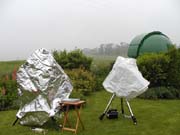
|
|
The first glimpse we had we were able to briefly observe
the disc of Venus without solar filters - the mist provided
protection. Then a considerable time passed before the
clouds gave way sufficiently to take any photographs. But
eventually, though still almost total cloud cover I was able
to obtain these images during a brief brightening with my
Olympus camera afocal on my LX90, using a 40 mm eyepiece,
the full Solar disc unzoomed, the close up 10x optical
zoom.
|
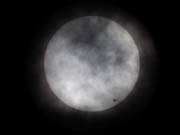
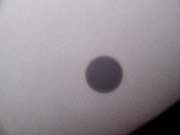
|
|
The previous day I had done some Webcam tests with the
Vesta Pro on my TMB on the Gemini mount in my Observatory,
barlowed x 2 to 1300 mm focal length. I left them set up,
and because the system was already focussed and aligned I
was able to take advantage of occasional brightening towards
the end of the transit and obtain several short (16 second)
avi's.
All of them had clouds scudding across, and only a few
were sufficiently consistent to stack, but each one was 50
frames, and stacking has effectively averaged out the
clouds, to give these images.
Disappointing, yes, but not a total failure. We both saw
some of the transit and obtained images. Maybe in 8 years
time I'll take a trip to a more favourable location. Wonder
what the weather will do then......
|




|
Dalby Forest 2004
|
The weekend of August 13-15 2004 was the annual
Scarborough Astronomical Society Star Fest. The weather had
been very wet and cloudy in the run up, but some clear
patches showed up on the Friday night, and Saturday dawned
bright and cloudless. Unfortunately the clouds rolled back
in on both Saturday and Sunday nights, so only a small
amount of observing was possible. Nevertheless there was
good fellowship and renewal of acquaintanceships!
|
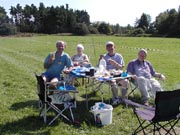
|
|
The clear daytime sky afforded some worthwhile Solar
observing on the Saturday, and although the Sun was well
past its period of maximum sunspot activity, there was a
substantial naked eye (with filter!) spot group visible,
photographed with a web camera through the TMB
refractor.
|

|
|
There was also a large prominence observable for a while
through my recently acquired Coronado
Helios 1 Solar 'scope. Again a webcam image.
|
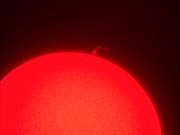
|
Isle of Man Observatory
|
During New Year 2006/7 celebrations I visited friends who
have recently moved to the Isle of Man. Many people will
know this small island in the Irish Sea for its wide variety
of scenery and terrain, and hosting of the annual Tourist
Trophy motorbike races. But of particular interest to
Astronomers is that most of the street lights on the Island
are switched off between 2 am and 6 am every night! Even
with the lights on, light pollution is relatively low, so
the skies are dark and there is a flourishing Astronomical
Society of around 150 members.
On a previous visit I had seen from a distance an
observatory on the Island, and when I found the Society via
the Internet and made contact, they most kindly allowed me
to visit on New Year's Day! The facility, entirely funded by
the Society and friends, is well located with excellent
views of the sky and a good distance from the major towns
yet very accessible by road. Most impressive with a huge 20
foot diameter dome! My partner Carolyn gives scale here.
If you are ever on the Island, it's worth contacting the
Society. And have a look at their web
site.
|
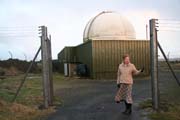
|
Kelling Heath Star Camp, September
2007
|
This annual
event at the Kelling
Heath Holiday Park in Norfolk is always well attended,
and this year was no exception, also blessed with fine dry
weather for the first week of the event. I was there from
Wednesday 12th to Monday 17th, and only experienced a brief
shower on the Sunday night, with most nights being cloud
free for much of the time.
|
|
|
There was some seriously high end equipment there -
Astrophysics 1200 mounts and a Software Bisque Paramount in
evidence, along with BIG Optics!
|
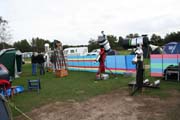
|
|
Arthur Edwards' fine 22" Dobsonian was among the biggest
there - when observing near the zenith you needed a good
head for heights!
|
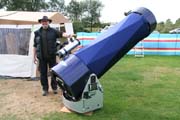
|
|
Among the trade stands on the Saturday 'main event' was
the innovative 'Pod' observatory. Definitely worth a look
for anyone in the market for a home unit. Marketed in the UK
by Altair
Astro
|
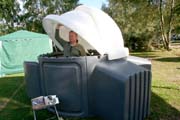
|
|
Not all Astronomy however. There is some delightful
woodland adjoining the site with many pleasant walks.
|
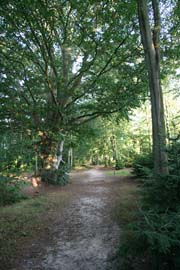
|
|
Trees also abound at the lower end of the tent field, so
early booking is essential to get a pitch with a clear view.
I was rather late this year! I took this photo as an
afterthought while packing up, so my telescope was already
put away. I was using my EQ6 Pro mount which I bought
secondhand late last year as a travel mount - I prefer to
leave my Gemini G41 permanently set up in my observatory.
The EQ6 performed satisfactorily!
|

|
|
As a consequence of my location, my sky was limited to
the 180 degrees Eastern section. So although M16 in Serpens
was reasonably high, by the time it was dark enough to image
it had crossed the meridian and was rapidly approaching the
trees. Always worth a try tho' and I managed to squeeze in 8
x 3 minute IR luminance and 2 each x 3 minute RGB before it
disappeared. SBIG ST8 and Mirage8 at f6.3. Full
size
|

|
|
On the other hand, Pegasus was well located for the bulk
of the evening and NGC 7331 (in the so called 'Deer Lick'
group) is always worth a visit! I collected data over two
nights, and this is the result. How many galaxies can you
see in this image? (Hint - more than 12!) Luminance 16 x 5
minutes, RGB each 5 x 5 minutes. SBIG ST8 and Mirage8 at
f6.3
This image and the above M16 image
appeared in the October 2007 issue of Practical
Astronomer
Full Size
|
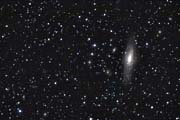
|
|
The Saturday night was particularly fine, and by the time
I'd collected more data on NGC 7331 Ursa Major began to rise
above the trees. M81 was the choice, and again I was able to
accumulate a reasonable amount of data, although eventually
cut short by the onset of twilight. The faint dispersed
galaxy UGC 5336 is just visible left of centre. Luminance 9
x 5 minutes, RGB each 3 x 5 minutes. SBIG ST8 and Mirage8 at
f6.3 Full Size
|
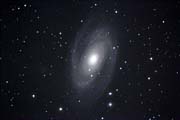
|


















